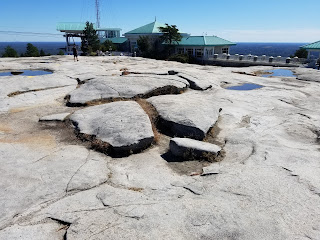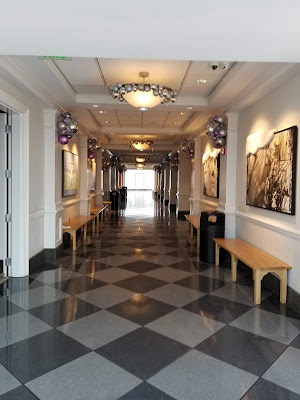#72 Stone Mountain
Welcome to Stone Mountain!
From the park gate to the
campground, you drive by two very nice looking golf courses.
Our full service campsites had
lots of room. We could see Stone
Mountain out our front window. We also had a tiny view of the lake through the trees and other campsites.
Stone Mountain started as a huge piece of granite that
formed under the earth. The softer soil
around it eroded and now this mountain of granite rises up on the Georgia
landscape.
The trees in the parking lot of the Skyride show signs of autumn.
We started our exploration of the mountain at the Skyride
tram. The mountain itself only rises 825
, feet above the land here: first surprise.
It measures 2 miles in length and 2 ½ miles in width. This view is from the tram going up.
The second surprise was seeing the elevation from sea
level at only 1683 feet.
Flashback moment! First Grade field trip!
The tram building offered a series of reader boards about the Stone Mountain Park: Erosion of Time, Erosion Water, Lichens and Moss, Rare and Endangered Species, Yellow Daisy (that only grows here), The Rock Pools, The Rocky Slopes, Forests, Mammals and Birds.
You step right out on this interesting landscape. The white stripe marks the path for people hiking from the base to the top.
Derrille and Jay did it in about 23 minutes up and back down. It was all uphill and so steep in places that handrails needed to be installed.
The different minerals that formed the granite rock have different degrees of hardness and unevenly distributed. Pits form when the softer minerals erode faster than the surrounding ones. Over millions of years wind and water create circular eddys. Plants that have taken hold, add organic acid to scour out and dissolve the granite.
Water collects in the depressions. Sometimes microorganisms grow and small plants.
You walk very carefully up here.
Much of the surface casts a green tinge from the lichen clinging to the rock.
Atlanta on one horizon, the east valley on the other.
I think this is a Loboly Pine. With lack of nutrients in the rock they don’t grow very big. The other trees are Red Cedars who average height on Stone Mountain only reaches about 6 feet.
Third surprise: I looked up and this truck was climbing right up the slope .
This represents part of the exfoliation of the rock. Exfoliation joints form when the mountain expands after the pressure of the overlying land decreases. Seasonal heating and cooling causes the granite to expand and contract resulting in larger cracks.
Interesting striations in the rock.
This relief in the side of Stone Mountain seems to be a
bragging point. However, we were not
impressed. The sculpture features
Jefferson Davis, Robert E. Lee and Stonewall Jackson. It is considered the largest sculpture of its
kind in the world. The entire carved surface measures 3 acres, larger than a
football field. The carving towers 400
feet above the ground and measures 90x190 feet. It is recessed 42 feet into
the mountain. Three sculptors worked on
the project. The first sculpture was the same man who did Mt. Rushmore, Gutzon
Borglum. He was hired in 1916, but because
of funding problems and WWI he couldn’t work on it until 1923. In a dispute in 1924, Borglum left. The second sculptor Augustus Lukeman took
over in 1925, but little was done by 1928 and funds ran out. The stone remained untouched for 36 years. In 1958 the
state purchased the property. In 1960 a
committee held a competition. In 1963 the work was commissioned to Walker
Kirkland Hancock. Work resumed in 1964
and got its finishing touches by 1972.
This smaller version of the relief hangs in Centennial
Hall.
Stone Mountain is adding a snow venue with tubing down fake snow. The construction work shows here. The Memorial building that use to tell the story of the mountain now be called the Snow Palace.
The information on the mountain had been moved to Centennial Hall. We watched a brief film on the Battle for Georgia depicting Atlanta’s part in the Civil War. Information about the famous relief was limited.
A museum described the geology of the mountain. Much was identical to the Geo Center we visited in St. John’s Newfoundland. The theme Landscape in Motion revealed geologic events.
Visuals show how Stone Mountain was born. Magma moved below the crust. One magma pool settled just below the surface. Then it cooled. A long time later, with erosion on the surface the granite rock stood exposed.
This exhibit describes the basic types of rock and how each is formed. I wished I could remember more of my geology classes.
In between each of these photo the monitor gave drawings to explain each process involved in the rock cycle. Here are just two.
I liked this saying.
The exhibit told about human impact on the mountain, and the unique
community of plants and animals here that include many rare, endangered and
unusual species.
The Pumpkin Festival was slated for the weekend. We went down on Friday to take a look but the
main exhibit had no trespassing signs.
These other ones were still being worked on. We considered coming back at night when they
lit up the displays, but the $35 stopped us.
Besides, fires burned in the campground and filled the night air with
smoke, so I couldn’t go out.
Tomorrow: Center for Puppetry Arts.














































































No comments:
Post a Comment